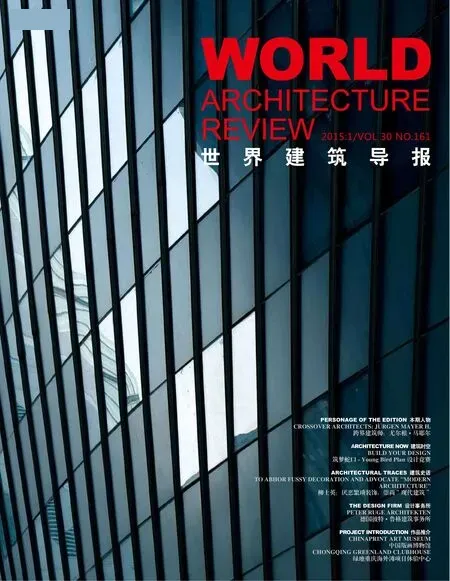以可持续发展作为特性
Peter Reischer, 记者
Peter Reischer, Journalist
以可持续发展作为特性
SUSTAINABILITY AS IDENTITY
Peter Reischer, 记者
Peter Reischer, Journalist
当你翻开这本书,看了前几页,你就会被这本书所吸引,一个充满标志,符号和图像的世界。建筑设计摆脱了其传统的满是建筑专业术语的世界,而是充满了很多无定形的表面和各种三维符号。这本书即是一个多元化的图形世界,这些符号在其后被发现是建筑师在实际建筑工作中所使用的。而这第一眼 -这些相邻的浮动图标就已经向我们展现了这个世界的多样性和Peter Ruge的设计精神。
作为一名建筑师,他与经典的现代风格步调一致,却又独特于表达和语言。即使从技术上看起来完全是日本建筑元素的亭子,或者是类似密斯凡德罗的极简形式,或又是被勒·柯布西耶称之为的野兽派艺术的表现风格,他没有排除任何当代的建筑流派,但他不只是简单地将他们囊括,而是将所有的不同元素消化吸收,将他的设计和环境,气候,社会和可持续发展结合起来。建筑真正变得因地制宜起来。当地人的需求,当地文化的特点都是他考虑的要点。正是在这些背景下,用不同的比例,用不同的材料,甚至强烈的反差对比,都充分体现了他融入当地文化背景的思路。另外,他还意识到形成自己的独特设计风格和特点,并使之符合现代社会的要求。注重时代的特性可以在他的家具设计中即体现得淋漓尽致。
Peter Ruge的设计项目不仅包括公寓,公寓楼,文化建筑,可持续发展规划,还有中国的大型居住区。你可以感受到,无论是80平方米的居住空间还是28平方公里的城市规划,Peter Ruge都无一例外给与同样的重视,投入同等的激情和关注。特别是,由于他超过20年作为一个建筑师和城市规划师的经验,这些图像的表达都是完全平衡平等的。
总的来说,这些漂浮的图像-如前面提到的可持续发展都是有益的。这个世界需要我们将这些想法传达给我们的后代,甚至可能是一个更好的想法。这样的态度是我们这个时代建筑创作所需要的特征。Peter Ruge 和他位于柏林的事务所,充分吸收各种建筑元素的精华,进而增加他们的对培养这些元素文化土壤的领悟,最后真正应用发展了这些元素。我相信,这样的过程是相辅相成的。
当你每年听闻气候峰会的失败,意识到本应达成的气候目标又一次无法实现时,毫无疑问Peter Ruge 的设计工作则是一个看得见摸得着的努力。在中国,这些可持续的想法正在得以实现。他认为可持续发展是一个解决问题的有效办法,他多年来一直支持资源节约型建筑结构。
在他的城市规划和问题解决方案中,显示了他对时间,空间,个人以及他们之间相互影响关系的独特理解。将宏观的形式巧妙地结合起来形成结构,这也在空间上转变成休憩和绿色空间从而促进沟通。
尤其是在中国,当地的很多建筑思路似乎不符合我们的欧洲的经典思维,在我们看来,Peter Ruge的观点是不是从西方的方法作为“启发”,但在选择一种跨文化的的融合过程。所以他不是将一个建筑简单地复制到中国,而是耐心地建议和修改设计来使他的作品被当地接受,这或许也是他在影响现代中国文化的过程吧。这种不寻常的态度使得他在中国绵阳城市可持续发展规划中获奖。这个绵阳玫瑰的规划设计是城市规划的典范。与法国哲学家罗兰·巴特的观点一致,符号学系统被Ruge在三个层面上所使用:能指,所指以及这两个部分的组合体,即符号。
If you look at the first few pages, the basis of this book, you will be visually drawn into a world, a world of signs, symbols and iconographic representations. We recognize architectural symbols emerging from the traditional characters, amorphous surfaces and three-dimensional indications— the world of architectural language. It is a diverse, partially graphic world, which finds its expression and its counterpart in the implementation of real buildings in the work of the architect. And this first sight —the adjacent floating icons — already shows the diversity of this world and the spiritual constitution of Peter Ruge.
As an architect, he is associated with the classic modern, unique in its expression and its language. but also with buildings that look almost Japanese in their rigor and discipline, such as light pavilion-like elements in the tradition of Mies van der Rohe and the so-called brutalism of le Corbusier. He excludes no contemporary trends in the architectural scene, but he does not regard parametricism as the result of a computer program, but rather of the joining and merging of all,the architecture and the relevant parameters such as the environment, the climate, and the social and sustainability context. The responsiveness to him of the location, and of the people who live there with their culture, are crucial for the creation of his buildings. Playing with conditions, with proportions, and contrasts in the materials also characterize his designs. but he is also aware of style elements and design features that convey the reference to the present day — especially in his furniture.
In family houses, apartment blocks and cultural buildings, concepts of sustainable planning,whole neighborhoods and major projects in China, 80 m2 of living space are treated with the same love and care as 28 km2 of urban planning. In particular, there is a balance of iconographic expression and sculptural shape due to his more than 20 years of professional experience as an architect and urban planner.
And over all it floats the — previously mentioned — sustainability, the idea that we are required to pass this world on to our children, and possibly even a better one. An attitude that was supposed to be characteristic of all architecture creators of our time. His architecture, as well as the concepts of his office — based in berlin — internalize thoughts on the origin of things, as well as on the culture in which they arise, and are truly contextual. Especially in the face of the failure of the annual climate summits and the consequent, and conscious, non-achievement of climate targets, Peter Ruge's work is a visible attempt, in a country such as China, to implement these ideas in the real world. sustainability is considered by him to be a problem-solving strategy, and his decision to support resource-saving architecture will show its validity for many years.
In his urban planning approaches and proposed solutions he displays a deep sense of time,space, relationships and the effect of individual components on human life and its users. large forms are skillfully combined to form structures, which in turn form spaces for recreation and green and thus enable communication.
Especially in China, where in our opinion an often almost diametrically opposite position on someissues of architecture exists, Ruge's view is not an “instructive” approach from the West,but a processon a cross-cultural meta-level. so it is not an export of architecture, but a gentle insemination by proposals and designs, which also recognize its symbolic impact on Chinese culture. The success ofthis unusual attitude is visible in the winning competition entry for sustainable urban development in Mianyang, in which the leaves of a rose form a model of urban planning. As in the analysis of theFrench philosopher Roland barthes, semiological systems are used by Ruge at three levels: thesignifier, the signified and the sign as an associative entity.

